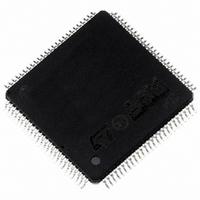STR736FV2T7 STMicroelectronics, STR736FV2T7 Datasheet - Page 6

STR736FV2T7
Manufacturer Part Number
STR736FV2T7
Description
IC MCU ARM7 256K FLASH 100-TQFP
Manufacturer
STMicroelectronics
Series
STR7r
Datasheet
1.STR735FZ2T7.pdf
(52 pages)
Specifications of STR736FV2T7
Core Processor
ARM7
Core Size
32-Bit
Speed
36MHz
Connectivity
I²C, SPI, UART/USART
Peripherals
DMA, POR, PWM, WDT
Number Of I /o
72
Program Memory Size
256KB (256K x 8)
Program Memory Type
FLASH
Ram Size
16K x 8
Voltage - Supply (vcc/vdd)
4.5 V ~ 5.5 V
Data Converters
A/D 12x10b
Oscillator Type
Internal
Operating Temperature
-40°C ~ 105°C
Package / Case
100-TQFP, 100-VQFP
For Use With
497-5046 - KIT TOOL FOR ST7/UPSD/STR7 MCU
Lead Free Status / RoHS Status
Lead free / RoHS Compliant
Eeprom Size
-
Other names
497-5146-2
Available stocks
Company
Part Number
Manufacturer
Quantity
Price
Company:
Part Number:
STR736FV2T7
Manufacturer:
SONY
Quantity:
101
Company:
Part Number:
STR736FV2T7
Manufacturer:
STMicroelectronics
Quantity:
10 000
Overview
Note:
2.1
6/52
Flexible clock control
Two clock sources are used to drive the microcontroller, a main clock driven by an external
crystal or ceramic resonator and an internal backup RC oscillator that operates at 2 MHz or
32 kHz. The embedded PLL can be configured to generate an internal system clock of up to
36 MHz. The PLL output frequency can be programmed using a wide selection of multipliers
and dividers.
Voltage regulators
The STR73xF requires an external 4.5 to 5.5 V power supply. There are two internal Voltage
Regulators for generating the 1.8 V power supply needed by the core and peripherals. The
main VR is switched off and the Low Power VR switched on when the application puts the
STR73xF in Low Power Wait for Interrupt (LPWFI) mode.
Low voltage detectors
The voltage regulator and Flash modules each have an embedded LVD that monitors the
internal 1.8 V supply. If the voltage drops below a certain threshold, the LVD will reset the
STR73xF.
An external power-on reset must be provided ensure the microcontroller starts-up correctly.
On-chip peripherals
CAN interfaces
The three CAN modules are compliant with the CAN specification V2.0 part B (active). The
bit rate can be programmed up to 1 MBaud. These are not available in the STR735 and
STR736.
DMA
4 DMA controllers, each with 4 data streams manage memory to memory, peripheral to
peripheral, peripheral to memory and memory to peripheral transfers. The DMA requests
are connected to TIM timers, BSPI0, BSPI1, BSPI2 and ADC. One of the streams can be
configured to be triggered by a software request, independently from any peripheral activity.
16-bit timers (TIM)
Each of the ten timers (six in 100-pin devices) have a 16-bit free-running counter with 7-bit
prescaler, up to two input capture/output compare functions, a pulse counter function, and a
PWM channel with selectable frequency. This provides a total of 16 independent PWMs (12
in 100-pin devices) when added with the PWM modules (see next paragraph).
PWM modules (PWM)
The six 16-bit PWM modules have independently programmable periods and duty-cycles,
with 5+3 bit prescaler factor.
Timebase timers (TB)
The three 16-bit timebase timers with 8-bit prescaler for general purpose time triggering
operations.
Real-time clock (RTC)
The RTC provides a set of continuously running counters driven by separate clock signal
derived from the main oscillator. The RTC can be used as a general timebase or
STR73xFxx


















